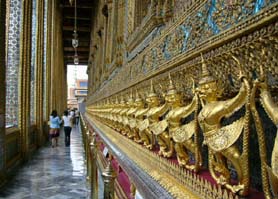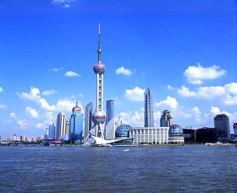Shanghai, "Hu" for short, is one of the four municipalities directly under the Central Government. During the  Warring States Period (475-221BC), Shanghai first belonged to the Yue State, then to the Chu State. King Lie of the Chu State appointed Huang Xie as his prime minister and bestowed him the title of Lord Chunshen. Shanghai was part of his fiefdom. Shanghai’s ancient moniker, “Shen,” derived from the Lord’s namesake. The name "Shanghai" actually came during the Song Dynasty (960-1279), when Shanghai began to rise as an international trade port. The Huangpu River, which runs through Shanghai and empties into the Yangtze River, has 18 creeks. One of these creeks was called "Shanghai Creek" - flowing past the present day Bund - bestowing on the settlement the name “Shanghai Town”. This name was later shortened to Shanghai, and referred to the entire populated area. By the Ming Dynasty (1368-1644), Shanghai had become China's largest textile center and business was developing fast. After the Opium War in 1840, Shanghai was opened as a trade port to foreign powers that set up their concessions there through imposing unequal treaties on China. In the century or more that followed, Shanghai became the largest base of imperialist aggression in China, known in the West as an "adventurers' paradise". A city with a glorious revolutionary record in modern Chinese history, Shanghai was where the Chinese Communist Party was founded in July 1921. On July 7, 1927, Shanghai was proclaimed as a special municipality. On May 27, 1949, Shanghai was really liberated. Warring States Period (475-221BC), Shanghai first belonged to the Yue State, then to the Chu State. King Lie of the Chu State appointed Huang Xie as his prime minister and bestowed him the title of Lord Chunshen. Shanghai was part of his fiefdom. Shanghai’s ancient moniker, “Shen,” derived from the Lord’s namesake. The name "Shanghai" actually came during the Song Dynasty (960-1279), when Shanghai began to rise as an international trade port. The Huangpu River, which runs through Shanghai and empties into the Yangtze River, has 18 creeks. One of these creeks was called "Shanghai Creek" - flowing past the present day Bund - bestowing on the settlement the name “Shanghai Town”. This name was later shortened to Shanghai, and referred to the entire populated area. By the Ming Dynasty (1368-1644), Shanghai had become China's largest textile center and business was developing fast. After the Opium War in 1840, Shanghai was opened as a trade port to foreign powers that set up their concessions there through imposing unequal treaties on China. In the century or more that followed, Shanghai became the largest base of imperialist aggression in China, known in the West as an "adventurers' paradise". A city with a glorious revolutionary record in modern Chinese history, Shanghai was where the Chinese Communist Party was founded in July 1921. On July 7, 1927, Shanghai was proclaimed as a special municipality. On May 27, 1949, Shanghai was really liberated.
Nowadays, Shanghai is the biggest city in China, as well as its commercial and financial heart. It is an important hub of communications with an easy access to the outside world by all means of transport: ocean, offshore and  inland water shipping, highway and railroad transport, air flights etc. Via the Yangtze River and the Huhang (Shanghai to Hangzhou) and Jingguang (Beijing to Shanghai) Railways, it becomes the communication hinge connecting all parts of China. As the biggest seaport in China as well as one of the ten largest seaports in China, the port of Shanghai has trade links with ports of over 100 countries and administrative regions. It also has over 40 inland and international airlines, connecting it with other Chinese cities as well as international cities, such as Tokyo, Osaka, Bombay, Athens, Geneva, Zurich and Karachi. About one third of China’s external communication is transmitted by Shanghai Satellite Ground Station and Sino-Japanese Benthonic Cable. As the biggest industrial center in China, Shanghai ranks first in industrial production as well as scientific and technological development. Its coastal area has an abundance of resources of fish and salt. Shanghai is situated at the Yangtze River delta, guarding the gateway of the Yangtze River in the north, facing the sea in the east and bordering the scenic city of Hangzhou Bay in the south. It is one of six most travelled sites in China. With its abundant beautiful gardens, cultural relics, museums and temples, Shanghai attracts thousands of visitors both from home and abroad every year. Some cultural performances of interest include Huju opera, Yueju opera, Shanghai burlesque, and Pingtan opera. inland water shipping, highway and railroad transport, air flights etc. Via the Yangtze River and the Huhang (Shanghai to Hangzhou) and Jingguang (Beijing to Shanghai) Railways, it becomes the communication hinge connecting all parts of China. As the biggest seaport in China as well as one of the ten largest seaports in China, the port of Shanghai has trade links with ports of over 100 countries and administrative regions. It also has over 40 inland and international airlines, connecting it with other Chinese cities as well as international cities, such as Tokyo, Osaka, Bombay, Athens, Geneva, Zurich and Karachi. About one third of China’s external communication is transmitted by Shanghai Satellite Ground Station and Sino-Japanese Benthonic Cable. As the biggest industrial center in China, Shanghai ranks first in industrial production as well as scientific and technological development. Its coastal area has an abundance of resources of fish and salt. Shanghai is situated at the Yangtze River delta, guarding the gateway of the Yangtze River in the north, facing the sea in the east and bordering the scenic city of Hangzhou Bay in the south. It is one of six most travelled sites in China. With its abundant beautiful gardens, cultural relics, museums and temples, Shanghai attracts thousands of visitors both from home and abroad every year. Some cultural performances of interest include Huju opera, Yueju opera, Shanghai burlesque, and Pingtan opera. |
